I had finished up a week in Moab, wheelin’ with some friends, and I noticed that the front drive shaft was squeaking. It was not constant, but rather an on again, off again kind of thing. After getting home, I decided it was time to pull the drive shaft and take a look. I had not felt any vibrations so my thoughts were to pull it as soon as possible and see if it just needed a fresh application of grease. With luck, nothing would be worn and a good cleaning/greasing would set things right again. If I got it apart and it was apparent that it had gone bad, I could drop down to the drive shaft shop in Phoenix and get some repair parts.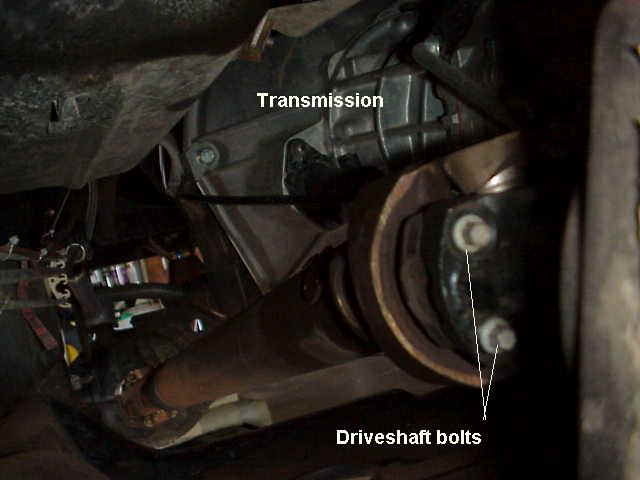
Sorry for the rather dark picture. This was taken from the back end of the skid plate, driver’s side. You can see two of the bolts that need to be removed in order to pull the drive shaft. These bolts attach the end of the CV joint to the output flange on the transfer case. I removed these two bolts, then rolled the Jeep just enough to rotate the front drive shaft a half turn. This brings the other two bolts into reach. I used an 8 mm six point socket with a universal and a 6″ extension in order to get them out.
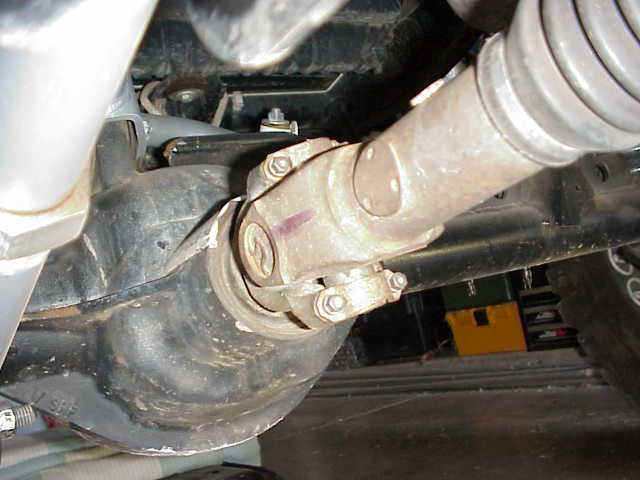
For the drive shaft and pinion yoke, the same 8mm socket I used on the t-case end of the drive shaft removed the u-joint straps at this end.
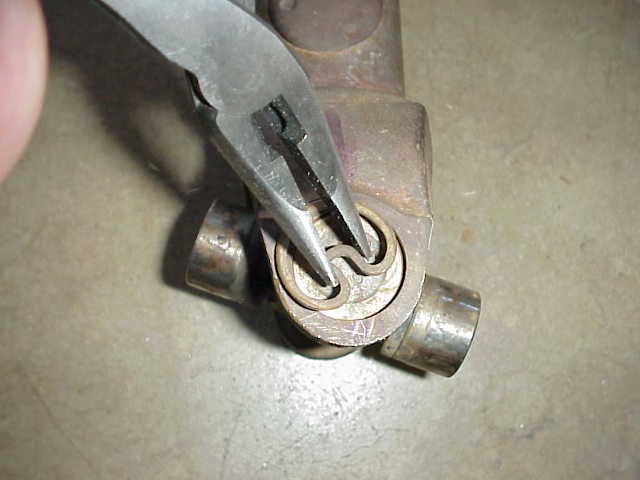
I used a strong pair of needle nose pliers to pull the clips from the end of the u-joint. I started on the differential end of the drive shaft, as shown in this picture. I had a spare Spicer u-joint in the trail box and decided to use it to replace the factory joint (36K miles on it). If the factory joint was in good condition, I would clean it up, apply some fresh synthetic grease, and put it back in the trail box for a spare.
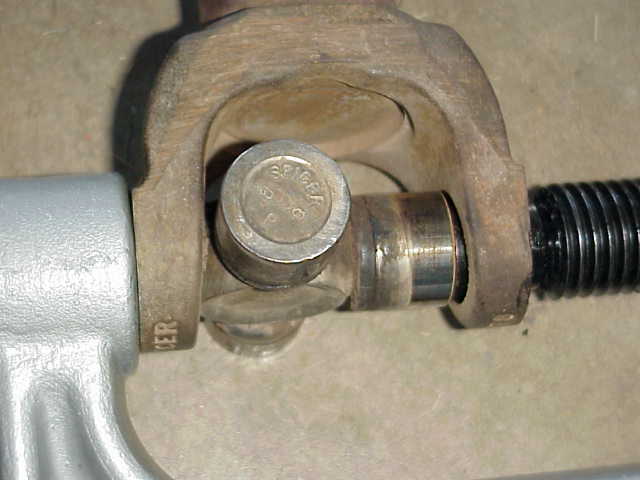
After the clips are removed, I broke out my Harbor Freight u-joint tool and proceeded to remove the Spicer factory u-joint. In this picture, you can see that I have just pushed one of the bearing caps out of the yoke with the press. Next, I just unscrew the press, flip it over, and push out the other bearing cap. I’ve mentioned it before in other write ups, but I’ll say it again….this is the handiest little trail tool anyone can own. I’ve used it on every u-joint on the TJ, except for the rear drive shaft (its time is coming!). (Note: 9/15/2002 I finally got around to using it on my buddy’s rear CV driveshaft….worked fine there too!)
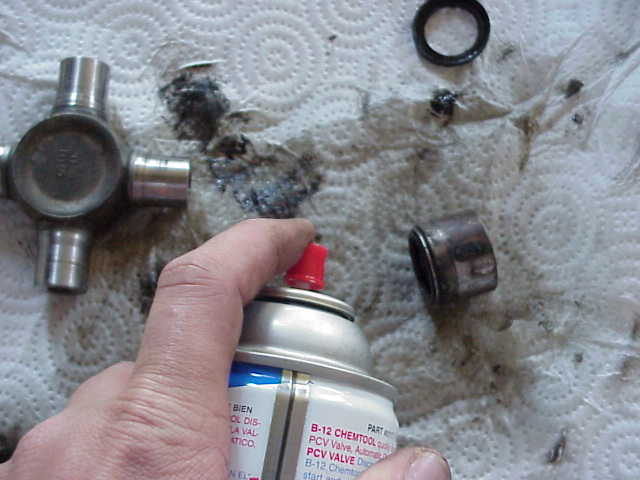
Since the factory u-joint was in pretty good shape, I used a little carb cleaner to clean out the bearing caps and remove the old grease from the u-joint. I then repacked the cavities in the cross with fresh grease, as well as the bearing caps. If you plan on keeping the u-joint as a spare, be careful not to lose any of the needle bearings in the caps. I always do mine over a couple of paper towels so if they fall out, I can usually find them (emphasis on the word “usually”).
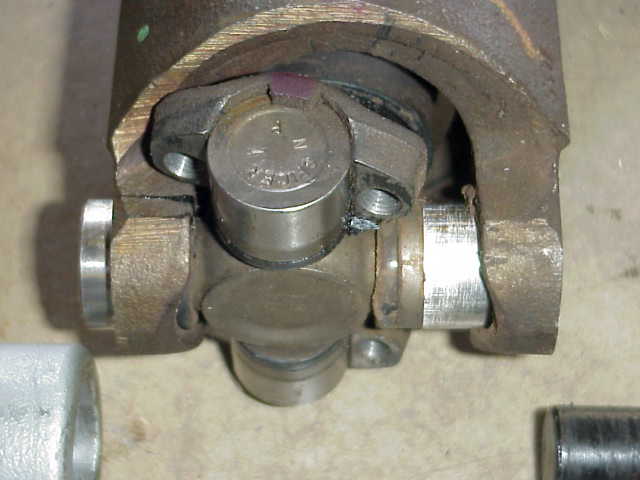
OK, the differential end of the drive shaft was taken care of. Time to see what the CV joint had in store for me. Again, I grabbed the u-joint press and pushed one of the bearing caps out as far as it would go. The yokes on the CV joint are a bit more restrictive (along with the socket yoke in the middle) and so I could not push the bearing cap all the way out. I looked at the factory service manual and they said to clamp the bearing cap in a vise.
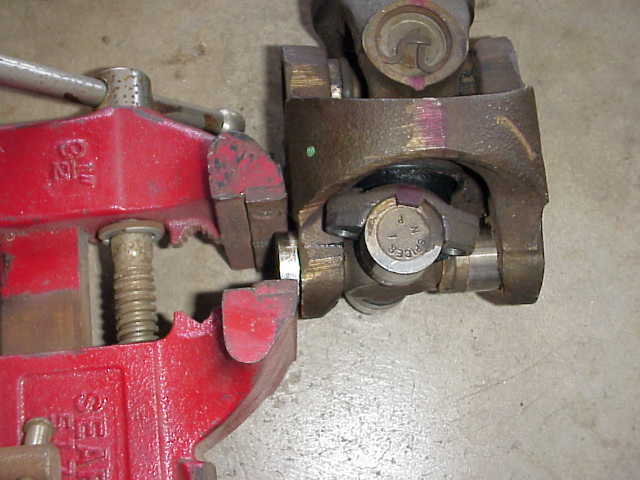
OK….so my bench vise wasn’t mounted on my work bench right now. Oh, what the heck….it still should work! So, I clamped the bearing cap in the jaws of the vice. A suitable sized hammer was found in the tool box and I proceeded to gently tap on the top of the vice jaw (hitting it right to left in the picture above).
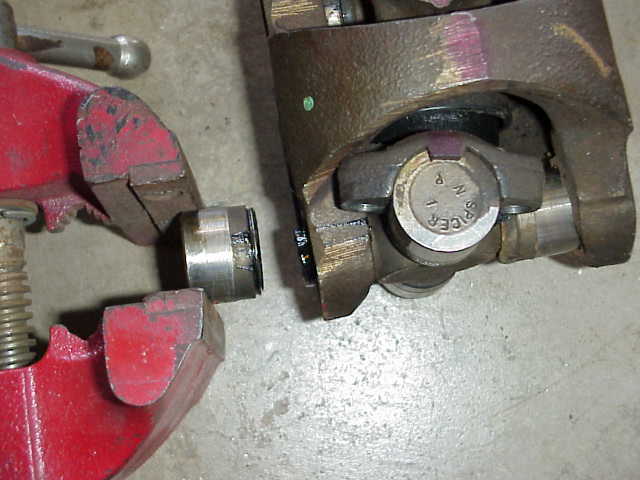
Sure enough….just a couple of light taps and the bearing cap came right out of the yoke. As I mentioned before, be careful here since you don’t want needle bearings all over the place.
This is probably a good place to comment on marking the entire CV joint you so you can put it back together properly. By this, I mean put some reference marks down one side of the entire assembly (and the drive shaft) so ensure everything goes back on the same way it came off. This will keep your drive shaft assembled the way it was when it was balanced (before being put on the vehicle). In the photo above, you can see some of the red permanent marker on the yoke assembly. I figured I should mention this hear since the factory service manual commented on it as well.
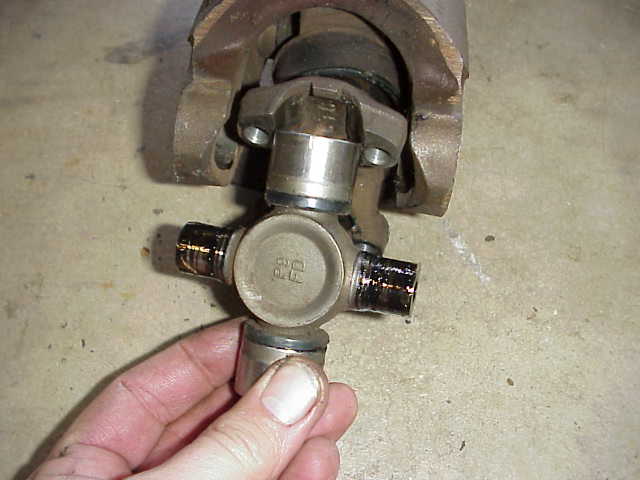
I flipped the u-joint press over and pushed the remaining bearing cap out as far as I could, then used the bench vise as I did in the above picture. Sure enough the first of the two u-joints in the CV assembly was out. I carefully examined the u-joint and could see no signs of failure or wear. I cleaned it up, as I had done the first one, and set it off to the side. I decided I would be using this one when I assembled the CV joint.
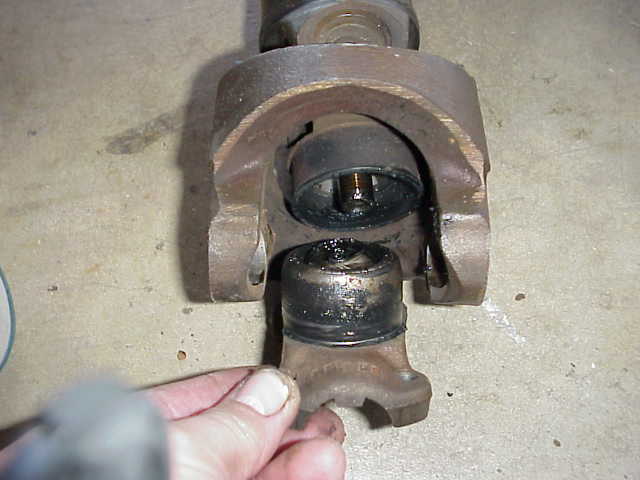
Be careful here….once the u-joint was removed the socket yoke (what I am holding in my fingers) was ready to fall out. It was rather grimey looking, so I did a careful cleaning on it as well. There is a small spring in the middle, so be sure not to lose it. There are also needle bearings inside the hole of the ball so don’t drop them out. Take note of how everything fits together, as you clean it up. Again, I could find no wear marks and the ball and socket were nice and tight….no slop there. I decided to recycle this part of the CV assembly as well. I probably spent 5~10 minutes on the ball assembly, first cleaning it and then packing it with grease. I wanted to make sure there would be a sufficient amount of grease in this part of the CV joint.
If you find that the CV assembly is worn out and requires replacement, check out Zach Matson’s comments on CV assembly overhaul. Zach put this write-up together when he discovered that his front drive shaft was in need of some work. A big thanks to Zach for sharing his experiences with us!
More Drive Shaft
TJ Front Drive Shaft Overhaul

Once again the press was used to take out the remaining u-joint. I had to use the bench vise in the same manner as before. No big deal….just takes a bit longer than when pushing them out in one step using the press.
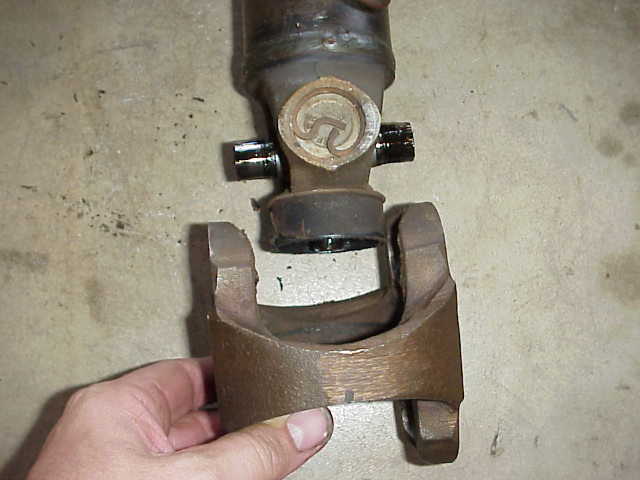
The main yoke of the CV joint is now free from the drive shaft. Just one more pair of bearing caps left and I’ll have the entire CV joint disassembled.
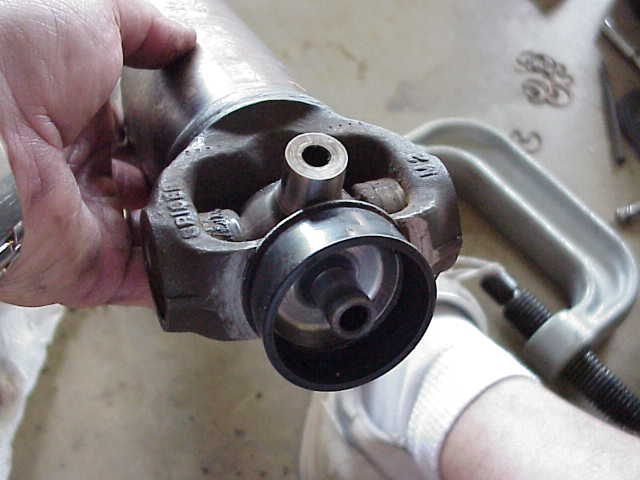
Again, I cleaned off the various parts and checked them for signs of wear or damage. There was none, so I would be using this part again as well. I cleaned out the socket very well and would be applying grease to this area when it was reassembled.
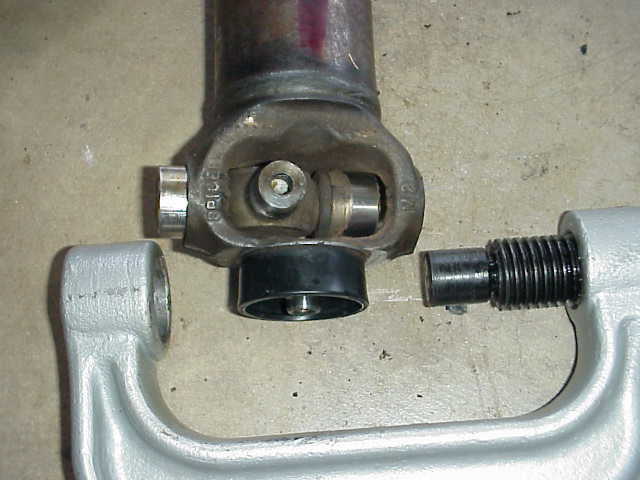
OK….so you really know how that u-joint press works now, right? I pressed out one of the remaining bearing caps and then clamped it in the vice and gently removed it from the yoke.
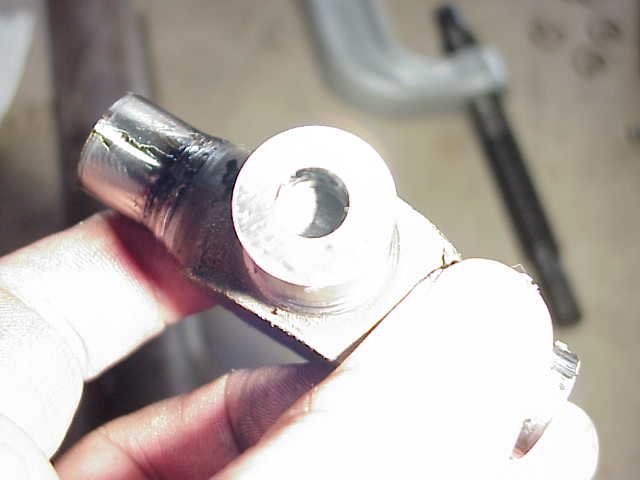
One thing I noticed on several of the u-joints was that the grease that is normally found in the cross area was missing (in 2 or 3 of the legs). I figured one of two things happened….it was all used up (but I saw no signs of it oozing through the bearing cap seals) or it was never put in there in the first place. I really don’t know which one of these is right, but you can bet I made certain that all of the crosses and bearing caps were liberally greased when I started putting everything back together.
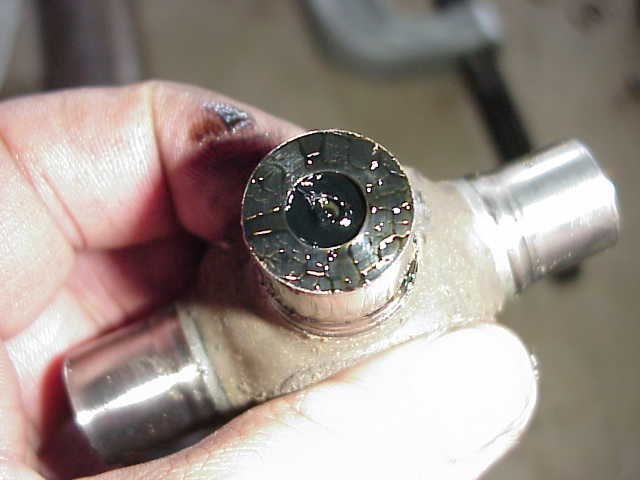
This is what you want it to look like. Packed full of grease. As the drive shaft spins, the grease in these channels are pushed out into the bearing caps by centrifugal force. This is what keeps a constant supply of fresh grease feeding into the needle bearings. If these grease channels are empty, there is no grease to lube the needle bearings and they soon fail. Right after that comes the failure of the u-joint itself and sometimes the yoke too. Hmmm…..sounds like a little bit of grease applied in the right areas is a pretty good idea!
More Drive Shaft
TJ Front Drive Shaft Overhaul

Well, that is about it. The rest of the time was spent putting everything back together once I had made sure that everything was properly greased. Here is the CV joint after it has been cleaned and assembled.
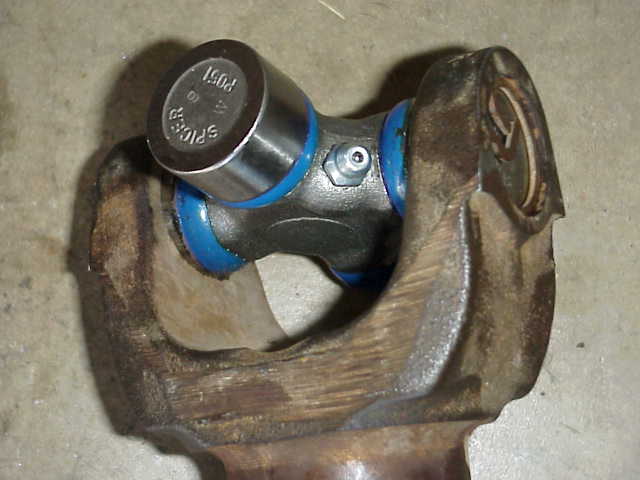
Here is the front diff end of the drive shaft. Check out those shiny blue dust seals….pretty cool. I decided to try this one with a grease zirk (actually, I bought the u-joint about two years ago) so at least I’ll be able to keep it well lubed.
That about wraps this project up. Basically, taking the front drive shaft apart is pretty straight forward. All you have to do is push out bearing caps (until you are blue in the face!). Next time I’ll probably have to replace the u-joints and centering ball. This time I got by OK with just some time used up on a Saturday morning.
Note: Here is a write-up for changing out the centering ball assembly.
Note: Here is some additional information for changing out individual parts of the centering ball assembly and also the part numbers for rebuilding a Rubicon front drive shaft.
Note: Here is some information on the grease used for u-joint lubrication.
